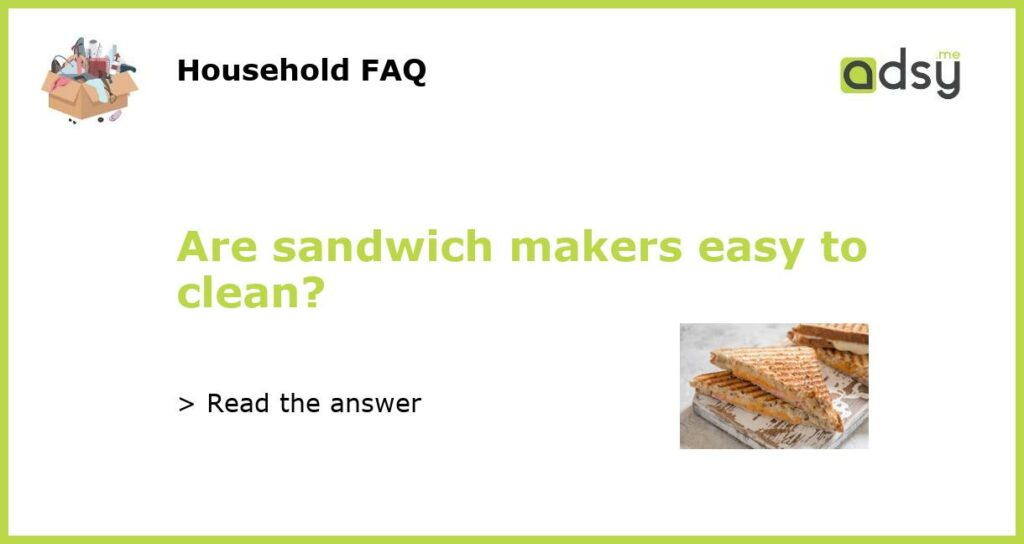Yes, sandwich makers are easy to clean
Using a sandwich maker can be a convenient and time-saving way to make delicious sandwiches at home. However, it is important to maintain the cleanliness of your sandwich maker to ensure food safety and optimal performance. Luckily, most sandwich makers are designed to be easy to clean, with removable plates and non-stick surfaces that make the process quick and hassle-free.
Simple steps to clean a sandwich maker
Cleaning a sandwich maker typically involves a few simple steps:
- Unplug the sandwich maker and let it cool completely before cleaning.
- Remove the plates from the sandwich maker, if they are removable. This can usually be done by pressing a release button or lever.
- Wipe down the plates and the inside of the sandwich maker with a damp cloth or sponge. Avoid using abrasive cleaners or utensils that could scratch the non-stick surface.
- For tougher stains or residue, you can use a gentle cleaning solution. Mix a small amount of dish soap with warm water and apply it to the affected areas. Let it sit for a few minutes, then wipe clean.
- Rinse the plates and wipe them dry before reattaching them to the sandwich maker. Make sure they are completely dry to prevent rust or mold.
Remember to always refer to the manufacturer’s instructions for specific cleaning recommendations for your sandwich maker.
Benefits of a non-stick surface
Many sandwich makers come with a non-stick surface, which makes it easier to clean and prevents food from sticking to the plates. This non-stick coating helps to reduce the amount of oil or butter needed to prevent sticking, making your sandwiches healthier. It also makes cleaning up after use a breeze, as food residue can be easily wiped away.
Tips for maintaining a clean sandwich maker
Here are some additional tips to help keep your sandwich maker clean:
- Avoid using metal utensils or abrasive cleaners that could scratch or damage the non-stick surface.
- Remove any excess food or crumbs from the sandwich maker before cleaning to prevent them from becoming stuck or burnt onto the plates.
- Regularly clean your sandwich maker after each use to prevent the buildup of grime and bacteria.
- Store your sandwich maker in a clean and dry place to prevent mold or mildew growth.
- Consider using parchment paper or aluminum foil to line the plates of your sandwich maker for easier cleanup.
By following these tips and regularly cleaning your sandwich maker, you can ensure that it remains in good condition and continues to make delicious sandwiches for years to come.
Other cleaning considerations
While the removable plates of most sandwich makers make cleaning easy, there are some models that have fixed plates. In such cases, cleaning the sandwich maker requires a bit more effort. However, you can still follow similar steps by wiping down the plates and the inner surfaces with a damp cloth or sponge. Use a cleaning solution if necessary, and make sure to dry the plates thoroughly before using or storing the sandwich maker.
It is worth noting that some sandwich makers also have dishwasher-safe plates, which can make the cleaning process even simpler. Just make sure to check the manufacturer’s instructions to ensure that the plates are dishwasher-safe before putting them in the dishwasher.



![Breville Ultimate Deep Fill Toastie Maker | 2 Slice Sandwich Toaster | Removable Non-Stick Plates | Stainless Steel | Black [VST082]](https://m.media-amazon.com/images/I/41Se9bKlf9L.jpg)

![Breville Sandwich/Panini Press & Toastie Maker | 3-Slice | Non-stick-coated aluminium plates | Stainless Steel [VST025]](https://m.media-amazon.com/images/I/41jVNciJynL.jpg)
